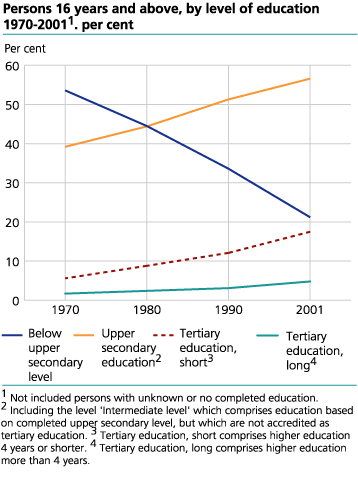Content
Published:
This is an archived release.
Sharp increase in educational level
Approximately 22 per cent of the Norway's population above the age of 16 has completed an education at a university or a college as opposed to about 7 per cent in 1970. The number with less than upper secondary education as their highest completed level has decreased by 50 per cent during the corresponding period.
In 1970 more than 50 per cent of Norway's population above the age of 16 had an education less than upper secondary as the highest completed level. In the autumn of 2001 the proportion was only 20 per cent. Every fifth inhabitant has completed some form of education at a tertiary level whereas in 1980 the rate was only every tenth. Persons with unknown or no completed education are not included in these figures.
Highest level of education in Oslo and Akershus
Oslo and Akershus are the counties with the largest proportion of inhabitants with a tertiary education, about 37 and 28 per cent respectively. 247 000 - or almost every third -, out of the total of 777 000 persons with some form of tertiary education live in Oslo or Akershus. Comparing the attainment of long tertiary education as their highest completed level, almost 70 000, or above 40 per cent, live in these counties. Hedmark, Oppland and Nordland, all with about16 per cent, have the lowest proportion of persons with a long tertiary education. Bærum, Asker, Oslo, Nesodden and Ås are the municipalities with the largest proportion of inhabitants with tertiary education. At the opposite end of the scale we find Værøy, Torsken, Beiarn, Karlsøy, and Moskenes. Oslo and Akershus also have the largest majority of persons with unknown or no completed education, but they are not included in these figures.
Men with longer tertiary education
The proportion of women with a short tertiary education as their highest completed level is larger than the proportion of men. 82 000 more women than men have some form of education from a university or college. On the other hand, more men than women have longer tertiary education, roughly 61 000 more men than women have completed such an education.
Gender differences
At all levels of education, most men have completed an education with focus on natural sciences. There is a female majority within education, health, and general subjects. However, most women with some form of a long tertiary education have, like the men, studied natural sciences.
Tables:
- Table 1 Persons 16 years and above, by level of education and county of residence. 1. October 2001
- Table 2 Persons 16 years and above, by level of education and municipality of residence. 1. October 2001
- Table 3 Persons 16 years and above, by highest completed education, gender and age. 1. October 2001. Per cent
- Table 4 Persons 16 years and above, by age, gender and highest completed education (level and area of study). 1. October 2001
Contact
-
Andrine Stengrundet
E-mail: andrine.stengrundet@ssb.no
tel.: (+47) 95 48 60 28
-
Anne Marie Rustad Holseter
E-mail: anne.marie.rustad.holseter@ssb.no
tel.: (+47) 93 45 98 35
-
Maj-Lisa Lervåg
E-mail: maj-lisa.lervag@ssb.no
tel.: (+47) 45 68 84 72

